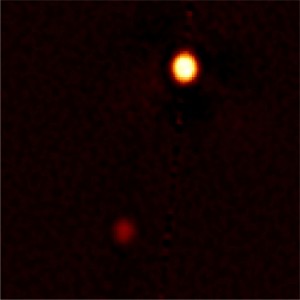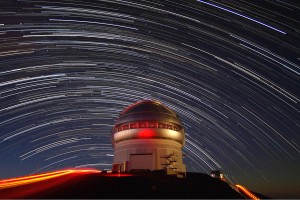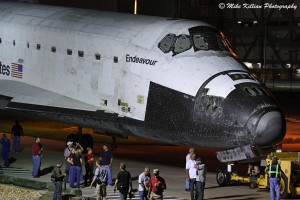I completely forgot yesterday was Wednesday. Rather, I remembered, but only as “Today is Wednesday, the day I talk to my developmental editor,” not as “Today is Wednesday, the day I remember that I have a blog I’m supposed to update at least once a week.”
It’s just as well I missed my regularly scheduled update because now I can write about yesterday’s press release from Gemini Observatory. The observatory announced that its astronomers have produced the sharpest image yet made using ground-based (Earth-based) instruments of Pluto and its largest companion, Charon.

Speckle image reconstruction of Pluto and Charon obtained in visible light at 692 nanometers (red) with the Gemini North 8-meter telescope using the Differential Speckle Survey Instrument (DSSI). Image credit: Gemini Observatory/NSF/NASA/AURA
The pixelated image might not look like much, but as the press release noted, it’s “the first speckle reconstructed image for Pluto and Charon from which astronomers obtained not only the separation and position angle for Charon, but also the diameters of the two bodies.” That’s pretty exciting—if anyone has tried to sell you the diameter of Pluto recently, he or she should have prefaced the number with the word “about.” Astronomers have been setting upper limits on the diameter since Pluto’s discovery in the 1930s (the 1960s seemed to be a particularly fertile decade for arguments on the topic), but still qualify their assertions with “± 20km”. I’ve been looking forward to the New Horizons arrival at Pluto in 2015, but the Gemini announcement makes the wait a little less painful.
Of everything I’ve read today, the comment I enjoyed most was made by Elliott Horch, coauthor of the Gemini study:
This was a fantastic opportunity to bring DSSI to Gemini North this past July. In just a little over half an hour of Pluto observations, collecting light with the large Gemini mirror, we obtained the best resolution ever with the DSSI instrument—it was stunning![1]
First, you gotta love the enthusiasm. I recently heard an NPR story about the development of robotic intelligence. The claim was that one day, humans would stop experiencing the “A-ha!” moment because robots would do all our thinking for us. I’m guessing Elliott Horch wouldn’t agree with that premise.
Second, the comment about “just a little over half an hour” caught my attention. It’s a little misleading, of course. As Horch knows, since he was in charge of the project to develop the instrument, hours and hours and hours went into the design and installation of the Differential Speckle Survey Instrument (DSSI).[2] But then again, this is how contemporary astronomy works: you request a time slot on a popular instrument and pray the weather, the instrument, and everything else in the universe that can affect your project goes the way you want it to go. Sometimes you get an entire evening with an optical instrument, sometimes you get a few nights, sometimes you have to change your project because there’s no open time available at all. When everything works out, well, then you see Charon and Pluto.
Today’s wallpaper celebrates the Gemini/DSSI/Korch team victory. Click on the observatory and star trails to reach the download page.
——————–
[1] Gemini Observatory Takes Sharpest Ground-Based Images Ever of Pluto and Charon (redOrbit.com)
[2] DSSI was installed temporarily at Gemini North last summer. It’s spent most of it’s observing life at Kitt Peak.





